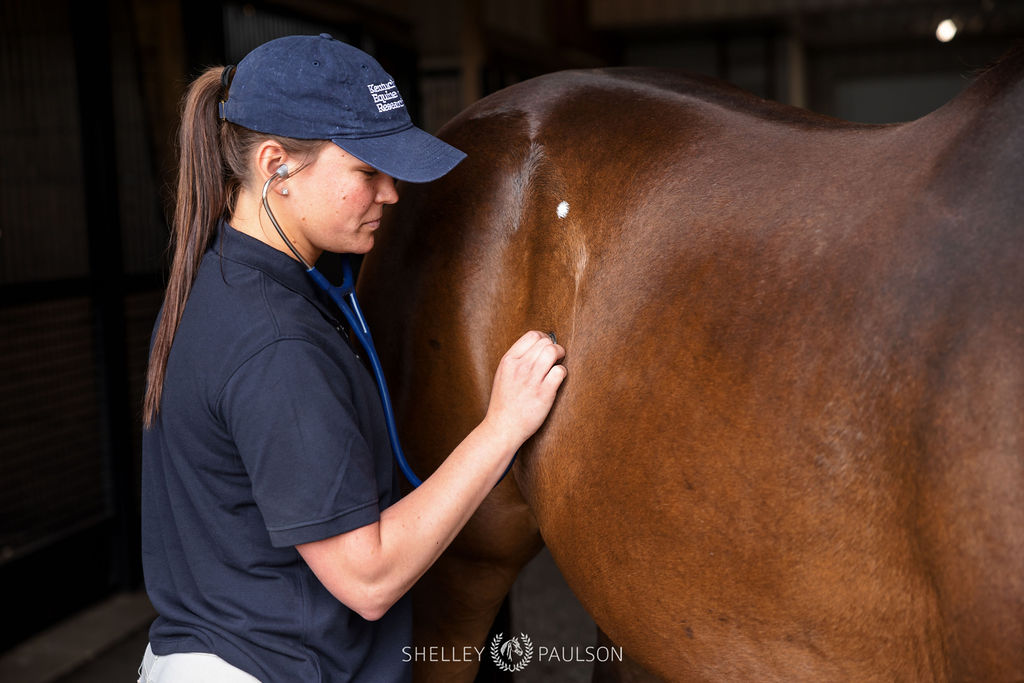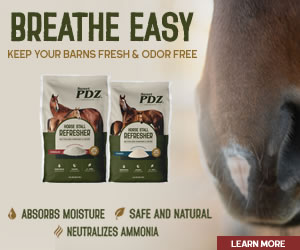Sponsored Content by Kentucky Equine Research: Modern feeding and management scenarios often place horses at risk for gastric ulcers. Common management practices that place horses at risk of gastric ulcers include meal feeding, diets high in concentrates and low in forage, intense training schedules, and social stressors.
The prevalence of gastric ulceration depends largely on breed, use, and disposition. Racehorses seem to be most bothered. In untrained Thoroughbreds, prevalence of equine squamous gastric disease (ESGD), which affects the upper portion of the stomach, is 37% but escalates to 80-100% within two to three months of race training. ESGD is not as prevalent in show and sport horses, ranging from 17-58%. Horses kept primarily at home and used in familiar environments have the lowest prevalence of ESGD at 11%.
Conversely, the prevalence of equine glandular gastric disease (EGGD), which damages the lower portion of the stomach, is less well documented but seemingly less widespread in racehorses and more common in leisure and sport horses.

Numerous clinical signs of equine gastric ulcer syndrome (EGUS) have been identified, though expression of these signs varies from one horse to the next.
- Poor appetite: feed intake is generally reduced, and some horses will lose their appetite for only certain elements of their ration, such as grain or hay.
- Loss of weight or body condition: weight loss is generally associated with reduced appetite, but may be attributed to chronic, low-level pain.
- Dull hair coat: perhaps due to weight loss and low-grade pain.
- Behavioral changes: often show signs of sourness toward horses and humans, including increased frequency of pinned ears and wringing tail; some horses become more reactive, while others become duller.
- Abdominal discomfort: some horses will lie down more frequently or will stand in a stretched position; ridden horses often express discomfort while adjusting the girth.
- Decline in performance: though this might be an effect of reduced energy consumption and weight loss, distraction due to pain could be the cause.
- Colic frequency: recurrent colic with mild to moderate pain has been identified in horses with gastric ulcers.
The only reliable method for diagnosing gastric ulceration is endoscopy, also known as “scoping,” which must be performed by a veterinarian. During gastroscopy, a thin, flexible tube outfitted with a camera is inserted into the mouth, threaded down the esophagus, and passed into the stomach, providing visualization of the stomach lining. Nutritional management strategies can reduce the risk of gastric ulceration. Key considerations include:
- Horses should be fed a forage-based diet. Continuous access to pasture forage may be preferable for at-risk horses, but free-choice hay or haylage can be fed to stabled horses that are not overweight. For overweight horses and ponies at risk of EGUS, hay with low energy content should be fed in small meals throughout the day with a goal of feeding no more than 1.5-1.7 lb. per 100 lb. of body weight daily. Horses on all-forage diets should be a ration balancer to ensure protein, vitamin, and mineral requirements are met.
- Feed concentrates only when necessary to satisfy energy requirements. Consider feeds that are low in starch with higher levels of fat (oil, stabilized rice bran) and fermentable fiber (beet pulp, soy hulls). Add chaff or alfalfa pellets to concentrate meals to dilute starch intake. Feed small concentrate meals, three or four times daily.
- If concentrates cannot be tolerated by especially sensitive horses, vegetable oil (canola oil) can provide energy to the diet. Mix oil with alfalfa pellets or chaff. Horses on high-fat diets should be supplemented with a natural-source vitamin E, such as Nano-E®, a research-proven product with superior bioavailability developed by Kentucky Equine Research.
A diet of high-quality forage (pasture, hay, or hay alternatives) and limited starch should reduce acidity of the stomach, support healing of the stomach lining, and decrease the likelihood of ulcer recurrence.
In addition to dietary changes, other pharmaceutical agents or supplements are available for the treatment or prevention of EGUS. Omeprazole is the only FDA-approved treatment for gastric ulcers in horses. Omeprazole blocks secretion of hydrochloric acid for 24 hours when given to horses at the recommended dosages. Further, antacids such as aluminum phosphate buffer gastric pH, and sucralfate buffers hydrochloric acid by increasing bicarbonate secretion and stimulating prostaglandin secretion.
For more information on Kentucky Equine Research digestive health products developed to support gastric health, visit ker.com/digestive-health. 
Kentucky Equine Research is an international equine nutrition, research, and consultation company serving horse owners and the feed industry. The company advances the industry's knowledge of equine nutrition and exercise physiology, applies that knowledge to produce healthier, more athletic horses, and supports the nutritional care of all horses throughout their lives. Learn more at ker.com .








